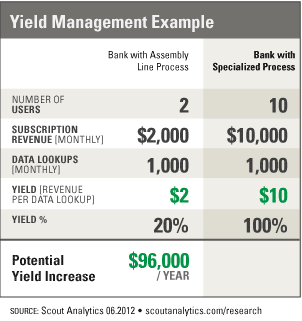Maximizing revenue from digital subscriptions is dependent on monetizing usage rather than the users themselves. Comparing print subscriptions to digital subscriptions highlights why usage behavior is the basis of revenue, and applying the principles of yield management shows why metered pricing models produce the most revenue.
Why Usage? Comparing Print vs. Digital Subscriptions
Based on the fact that print is a physically distributed product and digital is an on-demand service, print subscriptions differ from digital subscriptions in three critical ways:
- Fixed vs. Variable Content Delivery. The print product has a fixed definition of content delivery which is received by every customer that purchases a subscription. A digital service has a variable definition of content delivery because usage varies across customers.
- Ownership vs. Access Rights. When a customer subscribes to a print product, ownership of the physical assets now forms a library for use by anyone at any time. When a customer subscribes to a digital service, access rights are granted only for specific people and period of time.
- Customer Value Proposition. With a print subscription, the customer recognizes that they purchased and own all the information; whereas in a digital subscription, the customer wants to pay only for what they use.
The change in value proposition derived from ownership to usage moves the basis of monetization from media distribution to user behavior. Consequently, the most common pricing model is geared towards users, but per-user pricing does not sufficiently deal with variable content delivery. This is where the principles of yield management can be applied to maximize revenue.
Why Metered? Applying Yield Management Principles
Yield management is the process of understanding, anticipating and influencing consumer behavior in order to maximize yield or profits from a perishable resource. Because customers are paying for usage, and because customer usage behavior is a variable, transient revenue opportunity, yield management principles provide the means to maximize revenue. Once the customer uses content under a specific price plan, that usage has been monetized.
A yield management metric can measure and rate the price paid for each behavioral unit of usage (i.e., a behavioral unit price) allowing each subscription to be ranked based on yield. The behavioral unit price metric would answer the following question: did the pricing plan for the customer yield sufficient revenue from the customer usage behavior? If a pricing plan is not based on metering customer usage behavior, the answer will be “no,” as the following example illustrates.
Assume there is a financial information service that charges banks $1,000 per user per month for use of their service. The graphic to the right shows two different banks, in which the first bank processes all types of banking transactions in a single assembly line, with each person performing a specific function (e.g., data lookup in the financial information service). The second bank has a distributed process where  personnel specialize in different types of banking transactions, with each of them needing access to the financial information service. With these scenarios, these two banks have organized and staffed their transaction processing differently to accomplish the same goals.
personnel specialize in different types of banking transactions, with each of them needing access to the financial information service. With these scenarios, these two banks have organized and staffed their transaction processing differently to accomplish the same goals.
The assembly-line bank has only two users licensed for access to a financial information service at a price of $2,000 per month. The specialized-processing bank has ten users licensed to access the same financial information service at a price of $10,000 per month. Assuming each of these banks performs 1,000 data lookups per month, the assembly-line bank is paying $2 per data lookup, whereas the specialized-processing bank is paying $10 per data lookup. If $10 per data lookup is a fair market price, then $10 per lookup should be the target yield for all customers. In the case of the assembly-line bank, the yield is only $2 per data lookup, or 20% of the target yield percentage. The consequence is that the per-user pricing yielded $8,000 per month less than a pure metered price. On an annual basis, the yield is $96,000 lower, representing a significantly large missed revenue opportunity.
The Implication
Yield management is a critical competency for pricing managers to move beyond standard user pricing. Because yield management directly aligns price with customer usage behavior and ROI, developing behavioral unit prices allows a publisher to align and optimize license structure and prices. Developing tiered or metered pricing based on anticipated customer usage behavior is the path to maximizing revenue.






